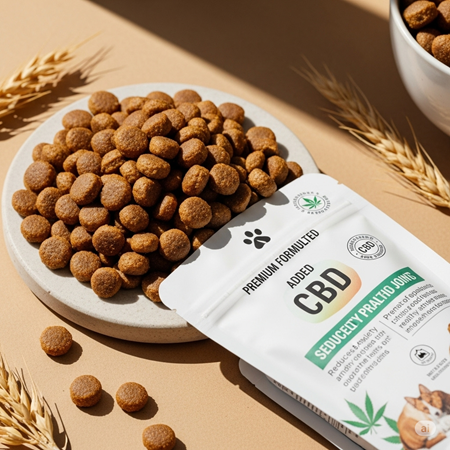
Cannabidiol (CBD) products for dogs and cats are now flooding the market as more and more pet parents search for nontoxic remedies for pain and other conditions in their animal. There’s considerable confusion all around regarding what, exactly, cannabidiol is and does, and how it differs from medical marijuana. Knowledgeable pet owners realize that exposure to marijuana can be toxic for dogs and cats.
CBD is a cannabinoid containing naturally occurring chemicals that act on the brain and body. The oil is produced from the cannabis plant and has no psychoactive properties like the THC (tetrahydrocannabinol) found in marijuana. Since it’s considered to have a wider range of medical benefits than THC, it can be a win-win for pets. CBD is extracted from cannabis plants and processed as an isolate or as a full-spectrum oil combined with other related cannabinoids.
CBD oils made with full-spectrum extracts are thought to have superior therapeutic effects versus cannabidiol-only oil. There are two common strains of cannabis in use today, hemp and marijuana. Hemp is a cannabis plant that contains less than 0.3% of THC; marijuana has more than 0.3%. CBD products for pets are typically sourced from hemp. Humans, dogs, cats, and all creatures with a spinal column have an endocannabinoid system (ECS). The ECS was discovered recently and named for the Cannabis sativa L. plant species due to the plant’s ability to dramatically affect it. The job of the ECS is to regulate functions such as eating, sleeping, relaxing, protecting, and forgetting by maintaining homeostasis via activators and receptors located in the central nervous system and immune system.
Cannabinoids function as messengers for the ECS, and their effects depend on the receptors to which they bind. This is a very specific process; a receptor will only accept a particular compound for which it exists and is unaffected by others. Reports on CBD include it’s use on senior animals that when used you just see a real difference in their spirit. They’re just not in pain, so they’re happier and they’re moving better. They just get a new lease on life. There are also cannabis tinctures for treating pet anxiety, loss of appetite, pain and inflammation, diseases like cancer and glaucoma, and kidney and liver problems.
A lot of pet owners turn to CBD when there are no other options and pharmaceuticals haven’t worked for that animal. They use it as a last resort, and cannabis is good for those types of situations. One of the most common applications for CBD is for anxiety and behavior issues in dogs. It seems to work very well at low dosages for hyper dogs. Further, cannabinoids have a strong affinity for the brain and nervous tissue and can easily cross the blood-brain barrier. This makes them helpful for certain types of seizure disorders as well as applications like post-traumatic stress disorder (PTSD). Pain management is another area where CBD products shine, even in cases of cancer pain.
One of the most important findings was that nearly 90% of dogs given CBD experienced a reduction in the frequency of seizures. 2 mg/kg of cannabidiol oil twice daily helped increase comfort and activity in dogs with osteoarthritis. If you’re already using a CBD product or are considering one, try to get a “Certificate of Analysis” which should show you how much THC is in the product (it should never be over 0.3%), how it’s made, and whether it’s organic, free of pesticides and other chemicals.
Related Articles
Debunking 6 Common Horse Myths
Why Does My Cat Refuse to Drink Water from His Bowl?
Why it is Important to Monitor Changes in Your Dog’s Eating Behavior


Comment here